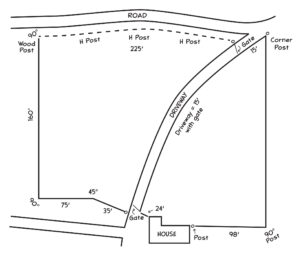
18 Aug Planning an Electric Fence Project
Planning an Electric Fence Project
How Do I Do That?
An electric fence is an effective way to keep animals in or out of a certain area, providing security and peace of mind for property owners. However, without proper planning, setting up an electric fence can become expensive and time-consuming. This article will guide you through the simplest and most cost-effective ways to plan an electric fence project.
- Define Your Purpose
Firstly, understand why you need the fence. Is it to contain animals like cattle or horses? If so, then also consider what you might add in the future. Is it to deter wildlife from a garden? Different animals require different types of fencing solutions.
- Survey the Area
Walk around the area you intend to fence. Take note of:
- Natural barriers (rivers, mountains)
- Potential access points
- Terrain type (flat, hilly, wooded)
This will give you an idea of the fence’s layout and the materials needed.
Another thing to consider is the possibility of any underground utilities. If there is any remote possibility that there could be water, power, phone, or gas lines in the area, contact your local utility companies.
If applicable, you need to identify the edge of your property so that you don’t accidentally fence land that belongs to someone else, or on the other hand, cutting off area that belongs to you. You must avoid blocking off an easement area as well. Check your property’s survey or deed for this information. If you don’t have one, you can request a copy from your county courthouse. Putting up a fence is hard work. Taking one down that’s in the wrong spot is costly, not to mention, embarrassing.
- Ask yourself these questions
What type of livestock will I be containing?
Do I have a pre-determined preference on how tall I want my fence to be?
How many strands and what kind of wire do I want to use?
- Map It Out
If you have aerial maps with the fence lines drawn out, send them to us. (Note: this can be done on Google maps.) If not, a hand drawn sketch will work just as well.
Indicate all corners and slight/major changes in the direction of the fence line. Also note dips, hills, and streams that may encounter the fence line.
Specify the material you will be using for corners/braces (e.g. Timeless Fence System bracing, wood, steel, or fiberglass). If using Timeless Fence System bracing, please specify which style you prefer (e.g. A-Frame, Classic H, Super H)
Mark the location of gates. Note: wherever possible, it is more cost effective to locate gates at corners. This eliminates the need for additional bracing.
Indicate the location of houses/barns where a fence line may be beginning and/or ending. This is useful in determining the type of bracing needed in this location.
When providing maps/sketches, please draw the fence lines and include the total linear footage of the entire fence.


- Send It To Us!
Email the maps/drawings to info@plastic-innovation.com. Please be sure to include the physical address of the property as well as a contact phone number. This helps us get you in touch with the right Timeless Fence representative should there be any follow up questions and also allows us to view the property on our software.
For more information and assistance with your electric fence contact our sales team here at Timeless Fence System.
or email us at


